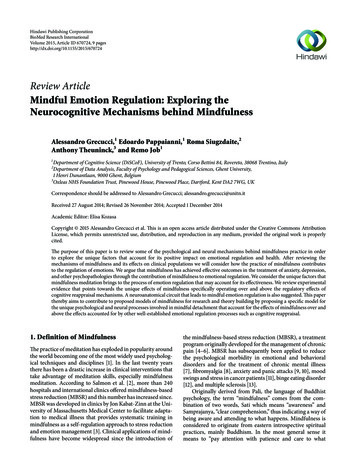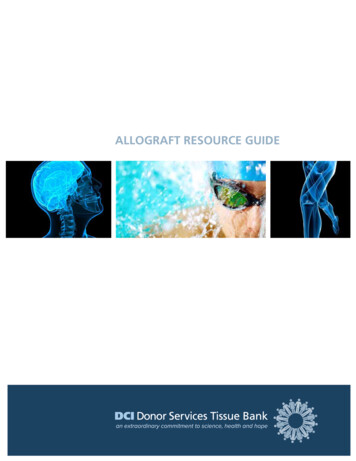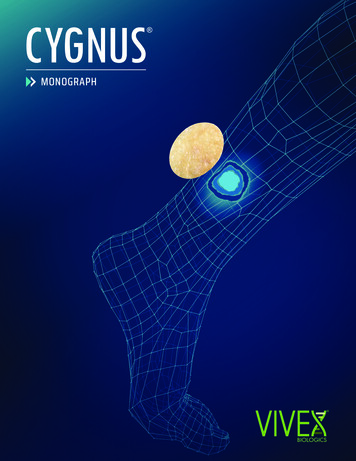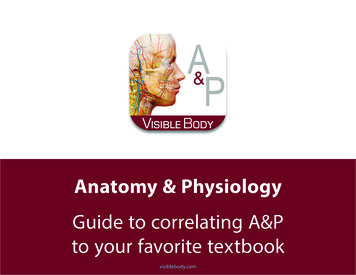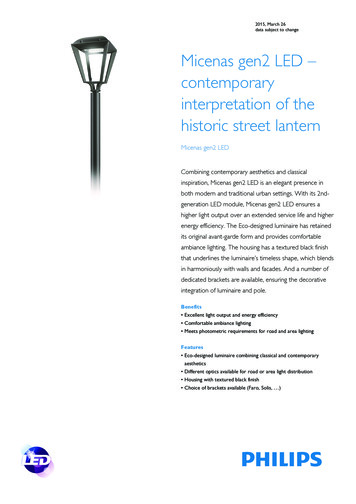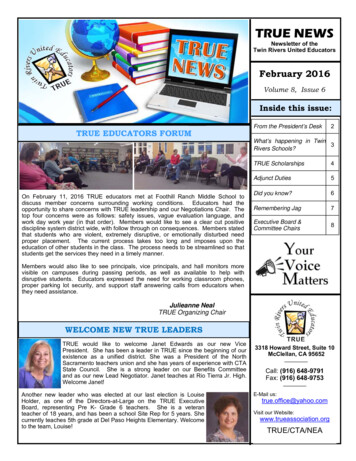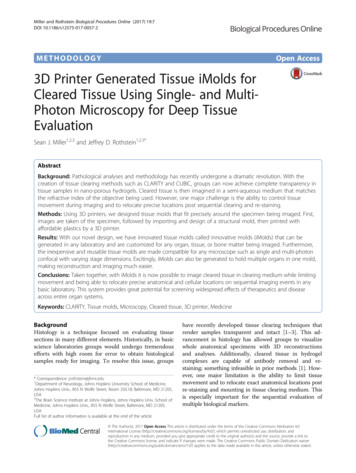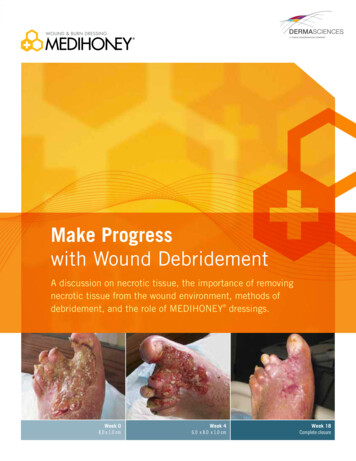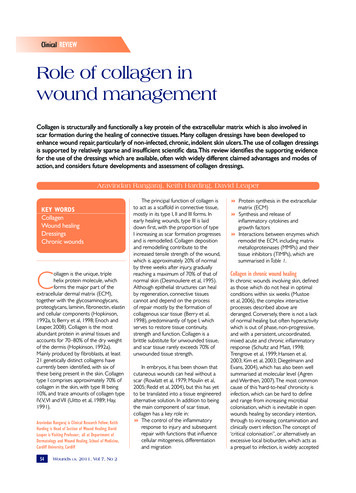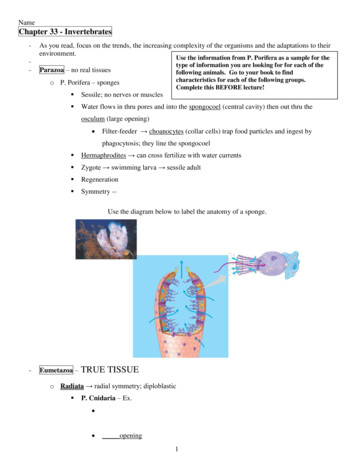
Transcription
NameChapter 33 - Invertebrates-As you read, focus on the trends, the increasing complexity of the organisms and the adaptations to theirenvironment.Parazoa – no real tissueso P. Porifera – spongesUse the information from P. Porifera as a sample for thetype of information you are looking for for each of thefollowing animals. Go to your book to findcharacteristics for each of the following groups.Complete this BEFORE lecture! Sessile; no nerves or muscles Water flows in thru pores and into the spongocoel (central cavity) then out thru theosculum (large opening) Filter-feeder choanocytes (collar cells) trap food particles and ingest byphagocytosis; they line the spongocoel Hermaphrodites can cross fertilize with water currents Zygote swimming larva sessile adult Regeneration Symmetry -Use the diagram below to label the anatomy of a sponge.-Eumetazoa –TRUE TISSUEo Radiata radial symmetry; diploblastic P. Cnidaria – Ex. opening1
2 forms:oo Nervous system Cnidocytes Nematocysts 1. What is the difference between a polyp and a medusa?Label the diagram below representing the life cycle of Obelia. P. Ctenophora – comb jellies Locomotion Tentacles and colloblasts o Bilateria bilateral symmetry; triploblastic Recall: Protostomes (characteristics) Deuterostomes (characteristics) Protostomes 1. Lophotrochozoa – have a lophophore (Definition )2
o P. Platyhelminthes – Ex. Symmetry – Number of tissue layers— Digestive system yes or no Number of openings Gastrulation (protostome or Deuterostome) Circulatory system Yes or no – Open or closed Gastrovascular cavity with openingo Cephalization eyespots vs. lateral flapso Nervous system o Reproduction o P. Rotifera – Ex. Pseudocoelomates Have organ systems and a complete digestive tract (mouth and anus) draws water into mouth Parthenogenesis Other types of eggs develop into males, but only long enough to make sperm zygote dormant during unfavorable conditions o P. Mollusca – Ex. Soft-bodied; most protected by a Body plan – 3 main parts 1. 2. 3. Fig. 33.16 pg. 656 Symmetry – Number of tissue layers— Digestive system yes or no Number of openings3
Gastrulation (protostome or Deuterostome) Circulatory system Yes or no – Open or closed Radula Both sexes; some hermaphrodite Trochophore Coelomates; open circulatory systemo Foot acts as a C. Gastropoda – Ex. ooo Grazers and predators – o Some are terrestrial with and without shells (snail vs. slugs) C. Bivalvia – Ex.oo Foot o Mantle 4
o No distinct head, no radulao Path of water C. Cephalopoda – Ex.o Built foro Carnivores; inject immobilizationo Chambered nautiluses o Move using ; can point in different directionso Giant squid o Closed circulatory system; will-developed nervous system with complex brain; welldeveloped eyesoo P. Annelida – Ex. Symmetry – Number of tissue layers— Digestive system yes or no Number of openings Gastrulation (protostome or Deuterostome) Circulatory system Yes or no – Open or closed Nervous system Respiratory organ (diffusion) Metanephridia Regeneration 5
3 classes: C. Oligochaeta – Ex.o Undigested food exits thru anuso Helps till the lando heado No parapodia (almost-feet locomotion) C. Polychaetao Has setae (bristles) and parapodiao Marine; crawl/ burrow on ocean floor Two well-adapted developments in annelids: 1. 2. 2. Ecdysozoa – Definition o P. Nematoda – Ex. Symmetry – Number of tissue layers— Digestive system yes or no Number of openings6
Gastrulation (protostome or Deuterostome) Circulatory system Yes or no – Open or closedo Non-segmented; pseudocoelomates Exoskeleton Reproduction/ Fertilization Important in ando Phylum. Arthropoda – Ex. MOST SUCCESSFUL OF ALL ANIMAL PHYLA Symmetry – Number of tissue layers— Digestive system yes or no Number of openings Gastrulation (protostome or Deuterostome) Circulatory system Yes or no – Open or closed Exoskeleton Jointed appendages Cephalization; well-developed sensory organs Hemolymph Organs specialized for gas exchange: Aquatic Terrestrial 4 main groups: 1.Groups can beclassified as phyla,subphyla, or classesdepending on thescheme 2. 3. 4.7
Much segmentation as arthropods evolved, segments fused and number of segmentsdecreased Chelicerates Ex. Chelicerae Cephalothorax and abdomen Class Arachnida – Ex.o One or two main partso pairs of appendages: 1 pair – 1 pair – 4 pairs –o Gas exchange o Spin silk webs Catches flying insects Spinning web inherited trait 3. Uniramianso Ex.o 1 pairo 1 pairo appendageso Class Diplopoda – Ex. pairs of legs per segmento Class Chilopoda – Ex. pair of legs per segmento Class Insecta – Ex. Now divided into several insect classes Most diverse class Entomology pairs of wings (on thorax)8
Wings Early function of wings Usually mate per lifetime Insects: HELPFUL HARMFUL 4. Crustaceanso Ex.oo Mainly aquatico pair compound eyeso Only arthropods with 2 pairs of antennaeoo Gas exchange o Circulatory system o Separate sexeso Larval stages o Several groups of crustaceans -----------------------------How many times did segmentation evolve in animals?- Still present (ex. vertebrae in backbone)- 3 theories:o origins of segmentationFig. 33.36 pg. 672o origins of segmentationo origin of segmentation9
Up to this point .Protostomes now . Deuterostomia P. Echinodermataoo Usually center with spokes (sea stars)o Thin skin covers o Water vascular system o Reproduction o Look radial, but actually have symmetryo All are marine C. Asteroidea – Ex. 5 or more arms with tube feet on the underside (locomotion, suction, grasping prey) Digestive System 10
Filter-feeder choanocytes (collar cells) trap food particles and ingest by phagocytosis; they line the spongocoel Hermaphrodites can cross fertilize with water currents Zygote swimming larva sessile adult Regeneration Symmetry -- Use the diagram below to label the anatomy of a sponge.
